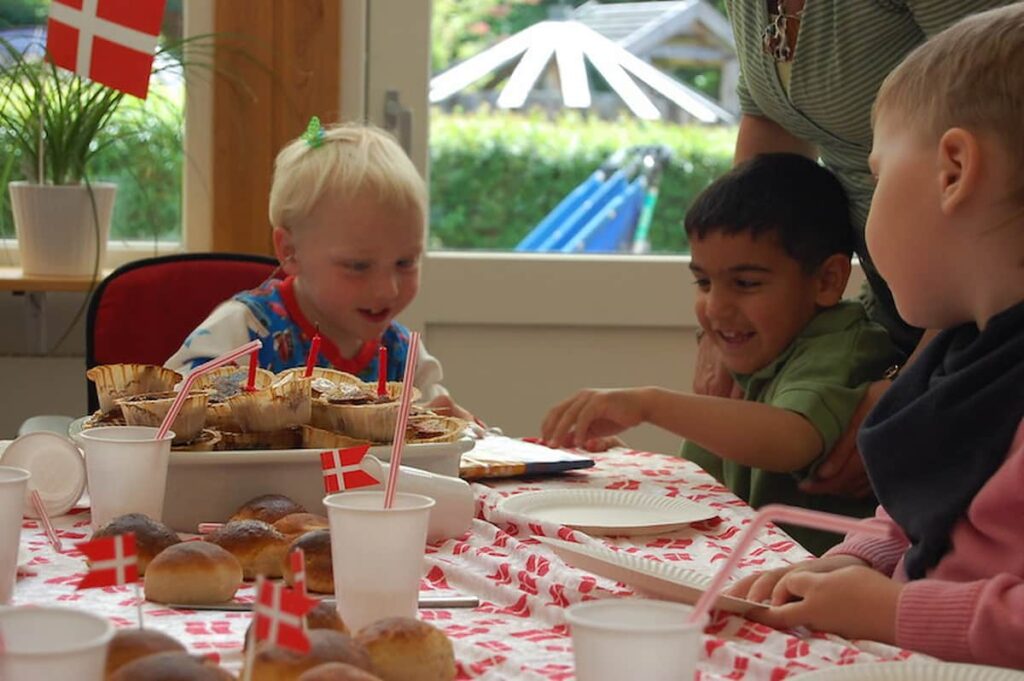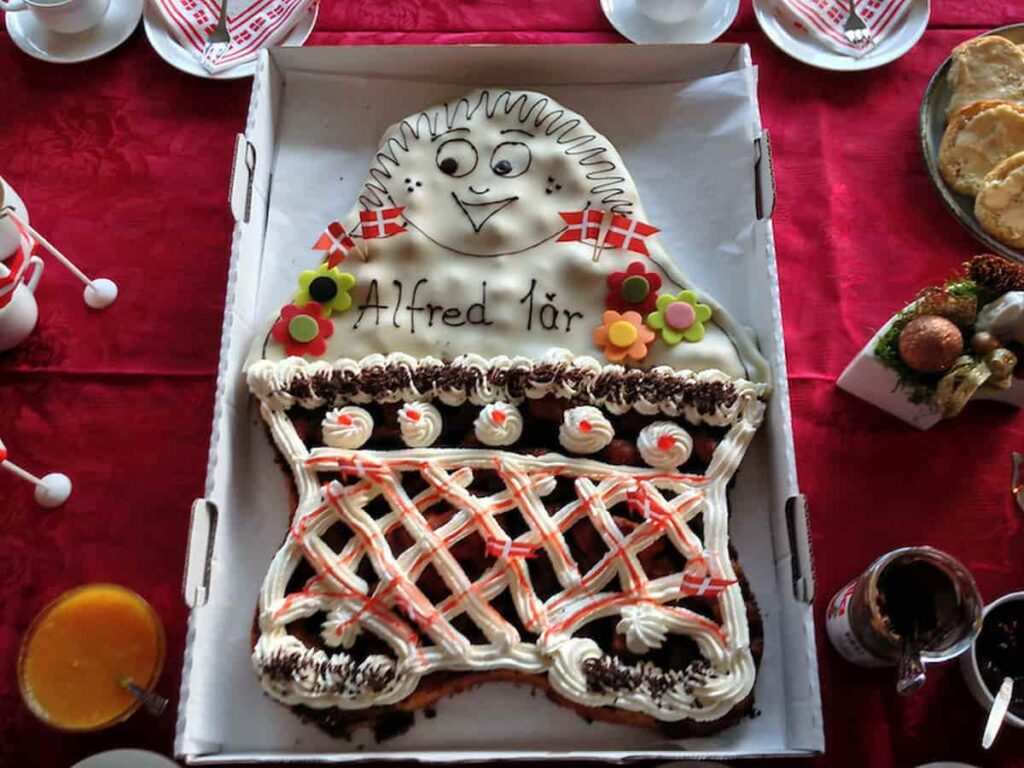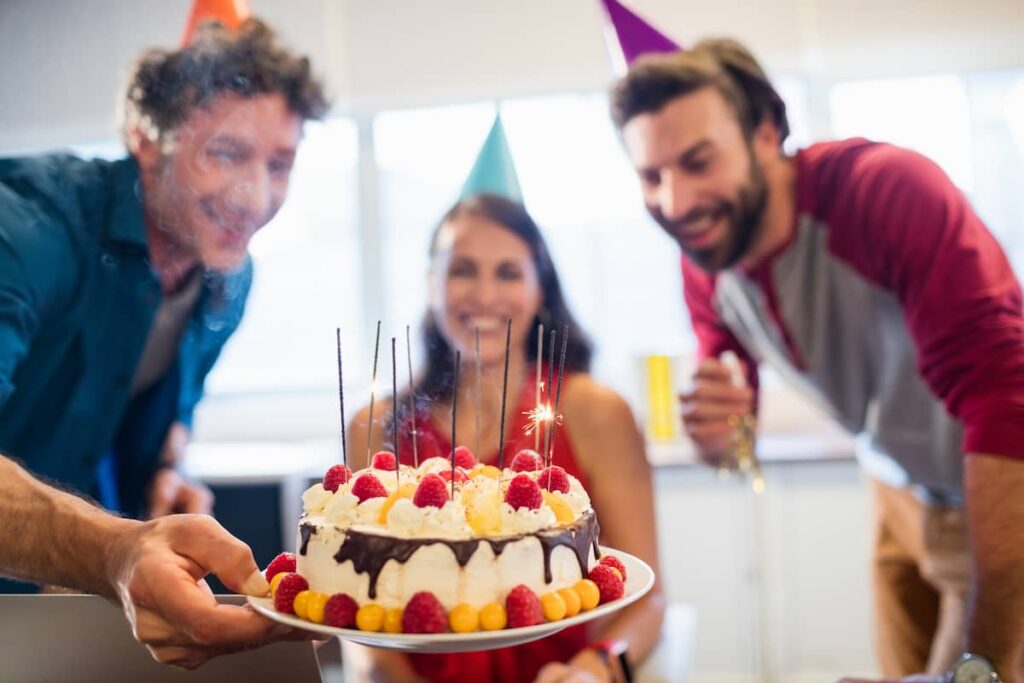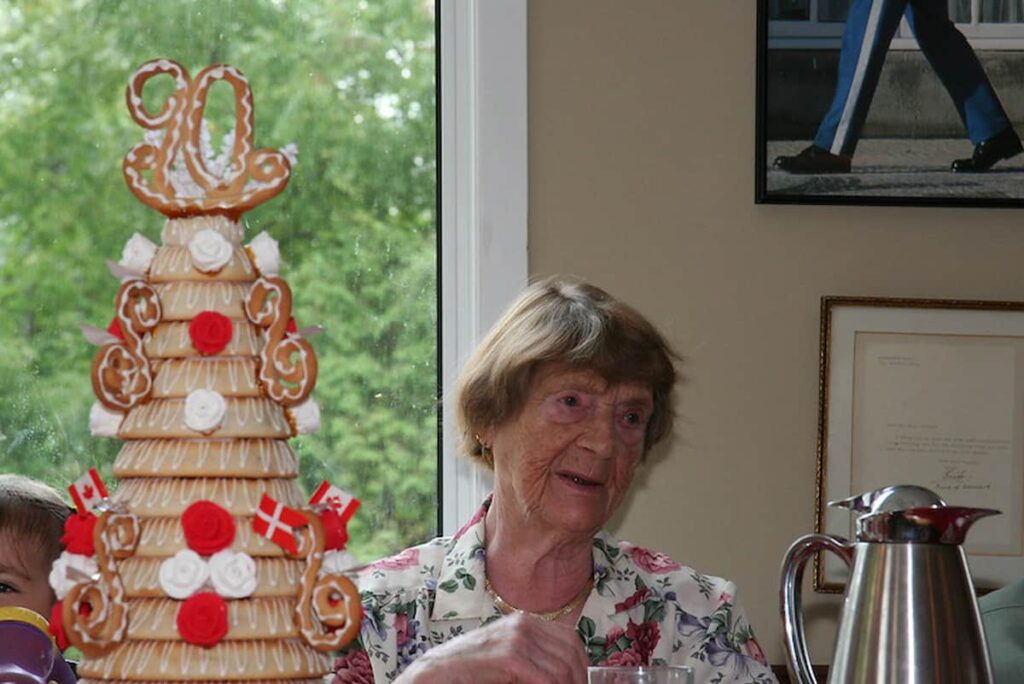Are you ready to dive into the world of Danish birthday traditions? From delicious cakes and thoughtful gifts, to unique customs and playful pranks, Danish birthday celebrations are a colorful mix of old customs and modern traditions.
Whether you’re a Dane or just visiting, you’ll want to know what to expect when it’s someone’s special day.
So, grab a slice of cake (which can be more violent than it sounds in this case, as you’ll find out below..) and let’s get started on exploring the charming world of Danish birthday celebrations!

Table of Contents
What are typical Danish birthday traditions?
The most typical Danish birthday traditions are the kagemand (cake man), a cake shaped and decorated like a person, and the fact that Danish flags are used everywhere as decoration for birthdays in Denmark. And I mean everywhere – on tables, walls, in the garden and more.
This isn’t some weird display of over the top patriotism or something like that. In fact, it’s really fun!
Actually, a lot of the Danish birthday traditions are very fun with everyone joining in with a lot of it. It’s for this reason that if you’ll be in Denmark for your birthday or if you’re about to, say, join a Danish workplace, it’s a good idea to be aware of what to expect.
I’ll take you through the main ones below.
Kagemand (cake man)
As mentioned above, the kagemand – or, nowadays, kagekone (cake woman) – is a big part of Danish birthdays. While it’s mainly for kids, I’ve definitely seen these come through my Danish office several times a year.
The kagemand is made from a sweet dough that is shaped and decorated to resemble a person. The dough is typically flavored with vanilla and lemon, and it is often filled with marzipan or a fruit jam.
The decoration of the kagemand varies, but it’s often decorated with icing, colored fondant, and various candies. Some bakers even go the extra mile to make the kagemand look like the birthday person, adding details such as glasses, hats or even a pipe.

When it’s time to cut the kagemand, the birthday person is typically the one who does the honors. They are usually given a special knife and they make the first cut…which is typically by cutting the cake man’s head off.
(I told you at the start that taking a piece of cake can be more violent than expected.)
This is your cue, with all the other onlookers, to scream at this horrific crime! And then to reach for a piece of delicious cake man because, come on, we all know why we’re here – for that sweet gooey marzipan goodness, of course.
You may also be interested in: Danish Bread (Rugbrød) and Pastries: The Ultimate Guide
Bring your own cake
In Danish offices, schools or similar places, it’s a tradition for the person celebrating their birthday to bring in a cake to share with their colleagues.
This may sound funny but think of the practicalities – no more will you all have to pool money for someone to run out at lunch and grab a last minute cake for a colleague. Or, worse, forget!

It makes for a nice way to celebrate the occasion and allows everyone to enjoy a slice of cake together with a break from the daily work routine.
If you don’t want to bring a kagemand, a more classic cake is also very much accepted. Many people choose a layered sponge cake, usually with cream and berries on top. While you can make it yourself, there’s no expectation to do this if you’d prefer to pass by the cake shop on the way to work instead.
Danish flags
I mentioned it before but it’s worth repeating as I seriously cannot understate the importance of the Danish flag in any birthday celebration.
You’ll see a small one standing on someone’s desk if it’s their birthday or, if you go out to dinner, at least one on their table. If you’re having a birthday meal at home, expect even more flags on the table, possibly including a Danish flag tablecloth.
It’s also typical to put flags up on the walls of the room where the birthday is being celebrated or even on your house or apartment door so guests know where to find the birthday person.

Having a birthday in a park? It’s very common to see flags stuck in a square around the picnic area.
And, of course, no Danish birthday cake is complete without at least one flag stuck in it.
It’s actually a really lovely Danish birthday tradition and very common, so get ready for a Dannebrog overload.
Related: Denmark vs England Flags: Who Influenced Whom?
Birthday song
No birthday is complete without a birthday song! And while every single Dane will know “Happy Birthday to You” in English, that’s not what’s sung on Danish birthdays.
Instead, you’ll hear the following:
Honestly, after so long living here, I still don’t know all the words by heart. But I can say from experience that the most important part is to know the “hurra, hurra, hurra” section to impress the Danes in your life.
If, however, you really want to take your Danish birthday experience all the way, here are the lyrics – with the English translation:
Danish/Dansk
I dag er det [name]s fødselsdag
Hurra, hurra, hurra!
han/hun sikkert sig en gave får
som han/hun har ønsket sig i år
med dejlig chokolade og kager til.
Og når han/hun hjem fra skole(/arbejde) går
Hurra, hurra, hurra!
så skal han/hun hjem og holde fest
og dem, som kommer med som gæst
får dejlig chokolade og kager til.
English
Today is [name’s] birthday,
Hooray hooray hooray!
S/he will surely get a gift
That s/he has wished for this year
And lovely chocolate and cakes.
And when s/he gets home from school/work
Hooray hooray hooray!
Then he has to go home and have a party
And whoever is coming as a guest
Will get nice chocolate and cakes.
Round birthdays
One of the most unique Danish birthday traditions is the “Rund fødselsdag,” or “Round birthday”. This is when someone celebrates their 30th, 40th, 50th, 60th, and so on, birthday.
On these milestone birthdays, it’s traditional for there to be a huge party. Often, the birthday person will book somewhere, like a restaurant or even a hall, although I’ve also been to amazing round birthdays in people’s gardens (when the weather behaves).

I’ve also heard of people simply putting a message in the local newspaper for anyone who knows the birthday person to come to a certain place on the day whenever they can, sort of like a birthday open house. This is more typical in smaller towns but makes it much easier than inviting a huge bunch of people.
Whichever it is, expect a ton of speeches and a TON of fun. You’ll also be eating and drinking a lot, so get ready for some Danish snaps.
25th and 30th birthdays
In addition to the traditions already mentioned, there is another custom associated with turning 25 and 30 in Denmark if the birthday person is (gasp!) unmarried.
If someone hasn’t reached that milestone by their 25th birthday, it’s traditional for their friends and family to cover them in cinnamon as a playful way to mark the occasion. The cinnamon is meant to be a symbol of sweetness and good luck, and it’s believed to bring good fortune to the birthday person.
And on their 30th birthday, if they’re still not married, the stakes are even higher. Just like with cinnamon, friends and family will take turns throwing pepper on the birthday person. Whether or not the pepper is, as some say, a symbol of maturity and wisdom or just a way to get back at the birthday person for some past indiscretion is still to be confirmed.
(It’s also worth mentioning that not everyone does this, so maybe discreetly check with your Danish friends if this is being done before launching cinnamon or pepper at someone out of nowhere.)
Royal birthdays
If you see Danish flags on buses around the city and it’s not a public holiday, it’s probably the birthday of someone in the Danish royal family.
But there’s an extra exciting event if it’s the Queen’s birthday on April 16th. At 12pm sharp, she and her family members will come out onto the balcony or at the entrance of whichever castle she’s in that year and wave to the crowd as they shout the happy birthday song at her.
(With plenty of flags, of course!)
You can usually get much closer than you expect so if you’re around on that date, try to head down there for some fun royal spotting!
How do you say happy birthday in Danish?
Happy birthday in Danish is “Tillykke med fødselsdagen”, which basically directly translates to “Congratulations on your birthday”. Other important birthday terms in Danish are “fødselsdag kage,” or birthday cake and “fødselsdagsgave” or birthday gift. However, knowing the Danish birthday song is most important!
Or, as I said above, at least knowing the “hurra, hurra, hurra” bit. The rest is – dare I say it – just icing on the cake!
